#SierraLeoneDecides: Displaced victims of mudslide hope for change

On August 14, 2016, the world woke up to heartbreaking news of a mudslide in Sierra Leone that left at least 500 dead and thousands others displaced.
Local media reported of victims of the disaster that took place a in Regent and Lumley districts of Sierra Leone’s caital Freetown being 162 male, 163 female, 70 boys and 86 girls and an additional 18.
Following three days of heavy rains the side of a hill collapsed in the early hours of fateful Monday, killing residents and destroying homes.
A seven-day mourning period was declared across the country by the outgoing President Ernest Bai Koroma.
As of 31 Aug, the total number of confirmed deaths was slightly above 500 and the number of missing persons was at 810. The results showed that a total of 5,951 people reported being affected by the mudslide and floods, 969 being children under the age of five and 393 pregnant and nursing women.
China and Ghana was among the many countries that sent in humanitarian aid for the people affected by the disaster.
According to the Chinese Embassy in Sierra Leone, in addition to donations from local Chinese companies and organizations, the Chinese government had decided to provide emergency humanitarian aid of one million U.S. dollars to the Sierra Leonean government.
More than five months later and the victims of the mudslide still remain homeless and few lucky ones have to put up with their relatives.
Isota Bangura is one of them and even though government promised to house them, their relocation is still uncertain. Many of the victims remain stranded and angry that authorities have not done enough to change their fortunes after the incidents.
CGTN’s Susan Mwongeli reports.
Sierra Leone is poised to prevent future disaster of like nature with the government planning to relocate people from disaster prone communities including the hill side and seaside communities respectively.
The capital Freetown is plagued by unregulated construction on its hillsides. The city is home to 40% of Sierra Leone’s urban population and is expected to increase by 3-5% in its various wards.
Authorities have been sensitized on the risk of more locations experiencing similar events and perhaps even more devastating. They have been advised on coming up with laws that will ensure land is reviewed and improved.






